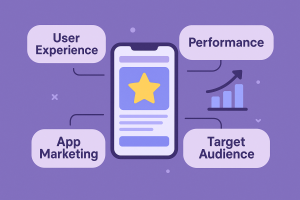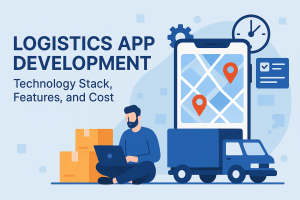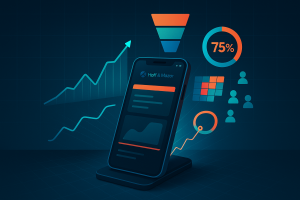Apple has long maintained a closed ecosystem for iOS, limiting app downloads to the App Store. However, with recent changes in regulations and a growing demand for flexibility, sideloading apps on iPhones has become a hot topic. Whether you’re an iOS enthusiast, developer, or business owner, understanding the process, risks, and benefits of sideloading apps can be valuable.
This guide will walk you through everything you need to know about sideloading apps on iPhone in 2025, including how it works, potential risks, and the advantages it offers. If you’re looking to build a custom app for iOS, you may also want to hire iOS app developers in USA to ensure a secure and smooth experience.
What Is Sideloading?
Sideloading refers to the process of installing apps on an iPhone from sources outside the Apple App Store. Instead of downloading an app directly through the App Store, users manually install the app using alternative methods.
This process is common on Android devices, where users can freely install apps from third-party sources. However, Apple update has traditionally restricted sideloading due to security concerns. In recent years, regulatory changes and increasing pressure from developers have made sideloading more accessible on iOS.
How Sideloading Works on iOS
Unlike Android, where sideloading is straightforward, installing apps outside the App Store on iOS requires a few extra steps. In 2025, there are several methods for sideloading apps onto an iPhone:
- Using Developer Mode – Apple allows developers to test their own apps using Xcode, which enables sideloading.
- Using AltStore – A third-party app store that allows users to install apps not approved by Apple.
- Using Sideloadly – A popular tool that helps users install IPA files (iOS app installation files).
- Through Enterprise Certificates – Some organizations use enterprise certificates to install internal apps without the App Store.
- Using Third-Party App Stores – With recent regulatory changes, alternative app marketplaces may become available for iOS users.
Is Sideloading Legal in 2025?
Sideloading apps on iPhone has been a controversial topic. In some cases, Apple has discouraged sideloading due to security risks. However, regulatory changes in the European Union and other regions have pushed Apple to allow third-party app installations under specific conditions.
As of 2025:
- In the European Union, Apple is required to allow sideloading due to the Digital Markets Act (DMA).
- In the United States, sideloading is still limited, but developers and users can install apps using alternative methods.
- In other regions, Apple continues to control app distribution strictly, but some workarounds exist.
If you’re unsure whether sideloading is permitted in your country, it’s best to consult legal sources or hire professional iOS app developers who understand the latest regulations.
How to Sideload Apps on iPhone in 2025
If you’re looking for a step-by-step guide on how to sideload apps on iOS US 2025, follow these methods carefully.
Method 1: Using AltStore
AltStore is one of the most reliable ways to sideload apps without jailbreaking your iPhone.
Steps:
- Download and install AltServer on your Mac or Windows PC.
- Connect your iPhone to your computer via USB.
- Open AltServer and install AltStore on your iPhone.
- Log in with your Apple ID (this is required to sign apps).
- Use AltStore to install and manage sideloaded apps.
Method 2: Using Sideloadly
Sideloadly allows users to install IPA files easily.
Steps:
- Download and install Sideloadly on your computer.
- Connect your iPhone and trust the connection.
- Download the IPA file of the app you want to install.
- Open Sideloadly and sign the IPA with your Apple ID.
- Install the app on your iPhone.
Method 3: Using Xcode (For Developers)
Developers can sideload apps using Apple’s official tool, Xcode.
Steps:
- Download Xcode from the Mac App Store.
- Open Xcode and create a new project.
- Connect your iPhone and select it as the build target.
- Import the app’s source code or IPA file.
- Compile and install the app on your device.
Risks of Sideloading Apps
While sideloading offers more freedom, it also comes with risks. Here are some potential dangers:
1. Security Vulnerabilities
Apple’s App Store has strict security measures. Sideloaded apps may contain malware or spyware, putting your data at risk.
2. Privacy Concerns
Apps installed outside the App Store may not follow Apple’s privacy policies, leading to unauthorized data collection.
3. App Instability
Sideloaded apps may crash or behave unpredictably because they haven’t been reviewed by Apple.
4. Revoked Certificates
If you sideload apps using an enterprise certificate, Apple may revoke it, causing the app to stop working.
5. Limited Updates
Unlike App Store apps, sideloaded apps may not receive automatic updates, leading to outdated software.
Benefits of Sideloading Apps
Despite the risks, sideloading offers several advantages, especially for developers and businesses.
1. Access to Unapproved Apps
Some useful apps are unavailable on the App Store due to Apple’s strict policies. Sideloading allows users to install these apps.
2. Testing and Development
Developers can test their apps before submitting them to the App Store.
3. Bypassing Regional Restrictions
Some apps are restricted in certain countries. Sideloading lets users install them regardless of location.
4. More Customization
Advanced users can install tweaks, themes, and modifications not available in the App Store.
Why You Might Need to Hire iOS App Developers
If you’re a business owner or entrepreneur looking to develop an iOS app, sideloading might not be the best long-term solution. Instead, working with professional iOS app developers can help you create an app that meets Apple’s requirements while maintaining security and reliability.
Advantages of Hiring iOS App Developers:
- They ensure your app meets Apple’s guidelines.
- They can develop secure, high-performance apps.
- They provide ongoing maintenance and updates.
- They help with App Store submission and approval.
If you need help building an app, there are top-notch iOS app developers for hire who specialize in creating custom solutions. Whether you want an App Store-approved app or a private enterprise solution, a professional developer can guide you through the process.
Future of Sideloading on iOS
The future of sideloading on iOS looks promising but remains uncertain. Apple has historically opposed sideloading, citing security and user experience concerns. However, with increasing regulatory pressure and user demand, the company may introduce more controlled sideloading options.
Potential Changes in Sideloading by 2026
- Apple-Approved Third-Party App Stores
- If Apple is forced to allow alternative app marketplaces, users may have access to verified third-party stores with safer sideloading options.
- Improved Developer Access
- Apple may expand developer programs to offer more flexibility for testing and distributing apps outside the App Store.
- Tighter Security Measures
- Apple could introduce more security layers to protect users from malicious sideloaded apps while maintaining a level of control.
Users interested in sideloading should keep an eye on Apple’s announcements and updates regarding app distribution policies.
Best Practices for Safe Sideloading
If you choose to sideload apps on your iPhone, follow these best practices to minimize risks:
1. Only Download Apps from Trusted Sources
- Avoid downloading apps from unknown or suspicious websites.
- Use reputable services like AltStore, Sideloadly, or official developer tools.
2. Check App Permissions
- Be cautious of apps requesting unnecessary permissions, such as access to contacts, messages, or location data.
3. Keep Your iOS Device Updated
- Regular updates help protect against security vulnerabilities that malicious apps might exploit.
4. Use a Secondary Device for Testing
- If you’re unsure about an app’s safety, install it on an older iPhone before using it on your main device.
5. Consider Using a VPN for Added Security
- A VPN can help protect your privacy when sideloading apps from third-party sources.
Common Misconceptions About Sideloading on iOS
There are several myths surrounding sideloading on iOS. Let’s clear up some common misconceptions:
Myth 1: Sideloading is Illegal
- Sideloading is legal in many countries, including the US and EU, though Apple discourages it. However, downloading pirated or unauthorized apps can be illegal.
Myth 2: Sideloading Requires Jailbreaking
- Many people think sideloading is only possible with a jailbroken iPhone. In reality, tools like AltStore and Sideloadly allow sideloading without jailbreaking.
Myth 3: Sideloaded Apps are Always Unsafe
- While sideloading carries risks, apps from reputable sources and developers can be just as secure as App Store apps.
Myth 4: Apple Can Permanently Block Sideloading
- Apple can restrict certain sideloading methods, but as long as alternative developer tools exist, sideloading will remain possible.
Final Thoughts on Sideloading in 2025
Sideloading on iPhones has become more accessible but still comes with trade-offs. While it allows greater freedom in app installation, users should be cautious about security and privacy risks.
For businesses and developers, sideloading can be a valuable tool for testing apps before launching them on the App Store. However, working with professional iOS app developers ensures your app is secure, optimized, and compliant with Apple’s standards.
If you’re looking to create a high-quality iOS app, there are iOS app developers for hire who can help bring your vision to life. Whether you need an App Store-approved app or an internal business application, experienced developers can provide the expertise needed for a seamless experience.







